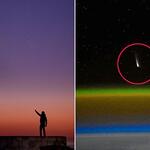Shooting Stars Sky Fireworks
On the night of October 8th, the Earth will pass through a meteor shower radiating from the constellation Draco, an event that stargazers await with great anticipation.
Peaking around midnight (8th into the 9th of October)
Source
Good News Network
On the night of October 8th, the Earth will pass through a meteor shower radiating from the constellation Draco, an event that stargazers await with great anticipation.
Peaking around midnight (8th into the 9th of October)
Source
Good News Network
In 2011, the Draconids approached a rate of 600 per hour; more than the hyper-active Geminids and Perseids, and in 1933, topped out at 6,000 per hour.
October is meteor season – there are seven meteor showers that reach peak activity during the month!
Valerie & Space Tourism Guide
October is meteor season – there are seven meteor showers that reach peak activity during the month!
Valerie & Space Tourism Guide
To find the constellation of Draco, the great serpent, its body snakes like the letter ‘S’ only backwards, with the tip and lowest section of its tail sitting between the Big Dipper (below) and the Little Dipper (above).
These shooting stars come from the comet 21/Giacobini-Zinner.
These shooting stars come from the comet 21/Giacobini-Zinner.
Skygazers to get once-in-a-lifetime chance to watch mesmerising A3 comet
Later tonight it will travel past the Earth at such close proximity it should be visible to the naked eye - even without binoculars or a telescope.
A3 was last visible at the end of last month, spotted by stargazers in San Francisco streaking over the Golden Gate Bridge.
Later tonight it will travel past the Earth at such close proximity it should be visible to the naked eye - even without binoculars or a telescope.
A3 was last visible at the end of last month, spotted by stargazers in San Francisco streaking over the Golden Gate Bridge.

Comet C/2023 A3 - also known as Tsuchinshan-Atlas - is believed to orbit the Sun once every 80,000 years, making its current trip through our solar system the first since humans began to move out of Africa.
A3 was discovered by researchers last year and first observed at China's Purple Mountain Observatory and an Atlas telescope in South Africa.
A3 was discovered by researchers last year and first observed at China's Purple Mountain Observatory and an Atlas telescope in South Africa.
 Once-in-a-lifetime chance to watch A3 comet tonight ...
Once-in-a-lifetime chance to watch A3 comet tonight ...